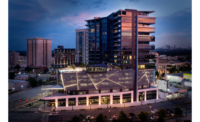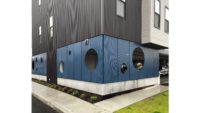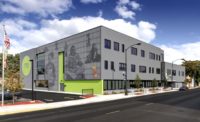Funeral traditions have shifted dramatically in the United States over the past few decades, with a majority of Americans now choosing cremation for themselves or loved ones. Funeral homes are responding by adding or improving crematory services and creating new spaces for family rituals. For one Arizona company this has meant upgrading existing equipment and adding accommodations for cremation viewing, which can add to or replace traditional wakes and visitation. Designers took an artful, outdoors approach to this viewing space, using metal panels to create a sanctuary where families and friends can witness a loved one’s cremation.
The space takes the form of a sheltered pavilion in what was previously a little-used carport, according to Bruce Spiegel, principal of The Phoenix – New York Company, the Phoenix-based architecture and landscape architecture firm that designed the project. When Best Funeral Services in Phoenix modernized its operations with smaller and more efficient cremation equipment, they also wanted to meet what they saw as a growing interest in a viewing space adjacent to the crematory.
“The idea was to create a sense of privacy for the family and a sense of privacy for the activities of the cremation,” Spiegel says. The little-used carport seemed an obvious location, but the combined needs for both visual separation and ventilation raised façade cladding as an important decision. “We had to provide shading to make it comfortable and, because it was an old carport, we wanted to ventilate the area with natural ventilation.”
Metal wall panels in a mix of solid, perforated and laser-cut designs proved to offer the right mix of privacy and openness, allowing attendees to feel protected from the desert sun while allowing air to pass through freely. For the solid and perforated panels, Spiegel opted for Petersen’s 7.2 exposed fastener panels, with 1,188 sq. ft. of it perforated with 22 percent open space and 202 sq. ft. left solid. All the 7.2 panels are fabricated from .040-gauge aluminum in a Colonial Red finish.
Spiegel says this choice was inspired by client interests. “His idea was to modify the building to look more modern. He’s also very eco-conscious and wanted materials that were recyclable and low-impact.” Ongoing maintenance also was a concern, the architect adds; Petersen’s PAC-CLAD solid panels come with a 30-year, non-prorated finish warranty, so a need for repainting won’t be a concern.
The overall design also has roots in the Southeast Asian cultures for whom cremation witnessing is an important rite. This can be seen in the delicate patterning of the laser-cut panels. “We wanted to get a tinge of that culture,” Spiegel explains. “The idea with the Petersen panels was this one of playing with light. You’re not in a dark space, you have a filtered, patterned light.”
Petersen offers a range of perforation options, so deciding on the right percentage of open space on the perforated panels was a balancing act, Spiegel says. “We had to have a certain amount of open space to provide ventilation,” which raised the question of, “how much can I see through this? We needed to provide privacy while also providing natural light to the space.”
The coordinated solid Petersen panels were placed strategically for added visual privacy. The space is illuminated for late afternoon and evening services, so the solid panels are at eye height to block views from the outside of visitation and cremation activities.
Get our new eMagazine delivered to your inbox every month.
Stay in the know on the latest in the wall and ceiling industry.
SUBSCRIBE NOWCopyright ©2024. All Rights Reserved BNP Media.
Design, CMS, Hosting & Web Development :: ePublishing










Report Abusive Comment